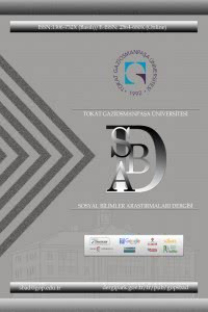SHAKESPEARE BAĞLAMINDA ERKEK EGEMENLİĞİNİN YARATTIĞI SİNDRELLA KOMPLEKSİ: HIRÇIN KIZ
Tiyatro sanatına yaptığı birçok katkı göz önüne alındığında, William Shakespeare büyük ölçüde İngiliz dili ve edebiyatının babası ve İngiliz tarihindeki en büyük oyun yazarı olarak dünya çapında kabul görmektedir. Shakespeare, şiirleri ve sonelerinin yanı sıra Elizabeth döneminin yaşam tarzını ve gelenek/göreneklerini temsil eden çeşitli etkileyici ve dünyaca tanınmış oyunlar kaleme almıştır. Yazarın bu tür eserleri ortaya koymasındaki temel amaç çağa ışık tutmak belki de toplumun kusurları olarak kabul ettiği konuları eleştirmektir. Komedilerinde bile Shakespeare, erkek egemenliğiyle ilgili ciddi açmazları içerisinde barındıran unsurları ön plana çıkararak, en tartışmalı komedileri arasında yer alan Hırçın Kız (1623)’da olduğu gibi, ciddi mesajları komik unsurlarla harmanlamaya özen göstermiştir. Bu çalışmada, Shakespeare’in Hırçın Kız adlı oyunu, Colette Dowling’in açıklığa kavuşturduğu ‘Sindrella Kompleksi’ kavramı üzerinden incelenmektedir. Özellikle, oyunun ‘hırçın’ karakteri Katherina’nın değişimi ‘Sindrella Kompleksi’ kavramına göre detaylandırılmaya çalışılmıştır. Çalışmanın bulguları sonuç kısmında verilmektedir.
Anahtar Kelimeler:
Sindrella Kompleksi, Hırçın, Erkek Egemenliği, Teslimiyet, İtaatkarlık
CINDERELLA COMPLEX CREATED THROUGH MALE DOMINANCE IN SHAKESPEAREAN CONTEXT: THE TAMING OF THE SHREW
Making a great many contributions to theatre itself, William Shakespeare has widely been acknowledged as the father of English language and literature as well as the greatest playwright in English history. Apart from his poems and sonnets, he produced several influential and well-known plays standing for the customs and lifestyle of Elizabethan age. His basic motif to create such works seems to shed light on the era, probably to criticize the issues which he postulated as flaws of the society. Even in his comedies, Shakespeare blended comic elements with critical messages as in The Taming of the Shrew (1623) ranking among the most debatable comedies while inholding some serious subject matters related to male hegemony in his age. In this present study, this play is analysed through the concept ‘Cinderella Complex’ explicated by Colette Dowling. Specifically, the shocking transformation of the ‘shrewish’ Katherina is detailed with regard to this concept. The findings are presented in the conclusion section of the study.
Keywords:
Cinderella Complex, Shrew, Male Hegemony, Submission, Obedience,
___
- Ackroyd, P. (2010). A Brief Guide to William Shakespeare without the Boring Bits, Running Press.
- Colson, R., O’Hara, S. & John, D. (Eds.) (2015). The Shakespeare Book. Penguin Random House.
- Crocker, H. A. (2010). Engendering shrews: medieval to early modern. Gender and Power in Shrew-Taming Narratives, 1500–1700 (Eds. Wootton, D. & Holderness, G.). Palgrave Macmillan.
- Dowling, C. (1991). The Cinderella Complex: Women's Hidden Fear of Independence. Pocket Books.
- Dusinberre, J. (1996). Shakespeare and the Nature of Women. London: Macmillan Publishers Limited.
- Foley, E. & Coates, B. (2018). Yetişkinlere Shakespeare (çev. Avcı, Z.). Helikopter Yayınları.
- Gay, P. (1994). As She Likes It, Shakespeare’s Unruly Women. Routledge.
- Giddens, A. (1992). The Transformation of Intimacy: Sexuality, Love and Eroticism in Modern Societies. Stanford University Press.
- Gündüz, İ. E. (2018). Gendered identities: Shakespeare’s Taming of the Shrew. Gaziantep University Journal of Social Sciences, 17(3), 834-844.
- Hjelm, M. L. (2016). “‟Tis Bargain‟d„ Twixt Us”: the reclamation of Kate in The Taming of the Shrew. Cultural Intertexts, 66-78.
- Holland, J. (2006). A Brief History of Misogyny: The World's Oldest Prejudice. London: Robinson.
- Kemp, T. D. (2010). Women in the Age of Shakespeare. Greenwood Press.
- Kumlu, E . (2020). Unveiling the Implicit Political Agenda: A Comparative Analysis of the Construction of Gender Roles in Grimm’s Ashputtel and Giuseppe Pitré’s The Magical Little Date Tree. Litera, 30 (1), 155-175. DOI: 10.26650/LITERA2020-0006
- Mill, J. S. (2017). Kadınların Köleleştirilmesi (trans. Özcan, A.). Bilge Kültür Sanat.
- Petzold, J. (2006). Subverting the master discourse? the power of women’s words in Shakespeare’s The Taming of the Shrew and Fletcher’s The Woman’s Prize, or The Tamer Tamed. AAA: Arbeiten aus Anglistik und Amerikanistik, 31(2), pp. 157-170.
- Rutter, C. C. (2001). Enter The Body: Women and Representation on Shakespeare’s Stage. Routledge.
- Shakespeare, W. (1998). The Taming of The Shrew. The Arden Shakespeare Complete Works (Eds. Proudfoot, R., Thompson, A. & Kastan, D. S.). Bloomsbury Publishing.
- Sönmez, A. (2000). Tristan Brolly ile “Hırçın Kız” Üzerine Söyleşi. Retrieved from http://feminisite.net/index.php/2000/06/tristan-brolly-ile-hircin-kiz-uzerine/ on 28th December, 2020.
- Wootton, D. & Holderness, G. (Eds.) (2010). Gender and Power in Shrew-Taming Narratives, 1500–1700. Palgrave Macmillan.
- ISSN: 1306-732X
- Yayın Aralığı: Yılda 2 Sayı
- Başlangıç: 2006
- Yayıncı: Gaziosmanpaşa Üniversitesi Sosyal Bilimler Enstitüsü
Sayıdaki Diğer Makaleler
Hamit (Kapancızâde) Bey'in Tokat Mutasarrıflığı (1912)
COVİD-19 SALGININDA KÜLTÜRLERARASI YENİ SELAMLAŞMA ARAYIŞLARI BİR ÇÖZÜM ÖNERİSİ
Selim GÜNGÖR, Nercü AYDIN, Aydın İNAK
Hamit (Kapancızâde) Bey'in Tokat Mutasarrıflığı (1912)
Selim GÜNGÖR, Aydın İNAK, Nercü AYDIN
SHAKESPEARE BAĞLAMINDA ERKEK EGEMENLİĞİNİN YARATTIĞI SİNDRELLA KOMPLEKSİ: HIRÇIN KIZ
Düşünceden Yaşantıya: Klişelerin Hükmü
Altuğ ÇAĞATAY, Emine Beyza AYKUTOĞLU, Oğuzhan ÇELİKSOY
AVRUPA BÖLGESİ ÜLKELERİNİN ENERJİ KULLANIMLARI AÇISINDAN BULANIK KÜMELEME YÖNTEMLERİ ile ANALİZİ
